Addressing Social Determinants of Health to Improve Diabetes Outcomes

Public housing residents often have complex health issues that are impacted by where they live. A report from the U.S. Department of Housing and Urban Development (HUD) shows that individuals that receive HUD assistance are more likely to have chronic health conditions such as diabetes and cardiovascular disease and are higher utilizers of health care than the rest of the U.S. population, and other low-income renters. other low-income renters.
Social, economic, and environmental factors, such as income, access to high quality health care services, and safe and healthy environments play a large role in determining the health status of public housing residents. A report by the National Center for Health in Public Housing (NCHPH) indicates that 60.5% of counties with Public Housing Primary Care (PHPC) health centers have high diabetes rates when compared to the total United States counties. Some public housing developments lack community assets, such as healthy food outlets and safe places to engage in physical activity, which can determine diet and exercise opportunities for diabetic patients living in or around public housing.
This publication will discuss seven different social determinants of health and their impact on diabetic patients: Educational attainment, job opportunities, access to health care, housing/community design, residential segregation, English proficiency, and housing.
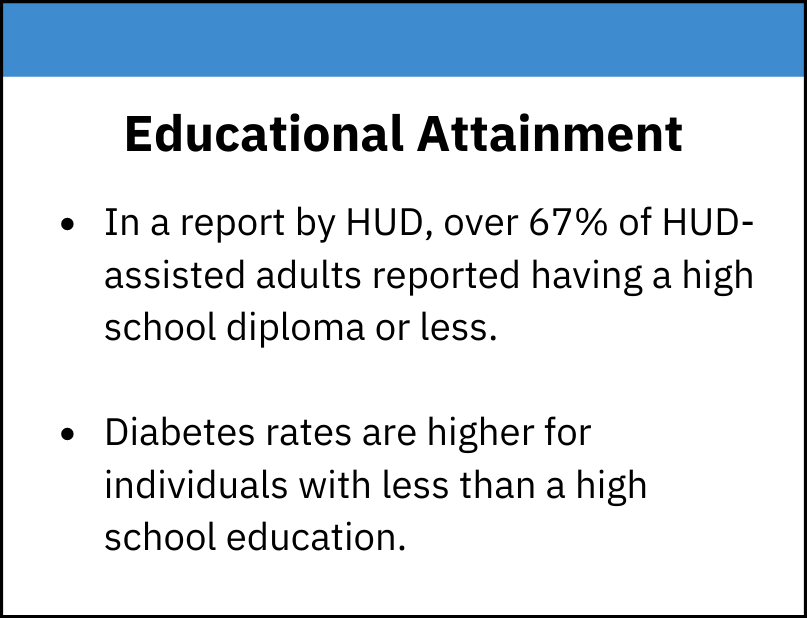
Educational Attainment
According to the National Diabetes Statistics Report, diabetes rates are higher for individuals who possess less than a high school education (13.3%) compared to individuals with terminal high school education (9.7%) and individuals with more than a high school education (7.5%).
In a report by HUD, over 67% of HUD-assisted adults reported having a high school diploma or less, which makes them more likely to have lower health literacy, have a poor understanding of diabetes and its complications, and were more likely to be overweight or obese, and develop prediabetes or diabetes when compared to the US general population.
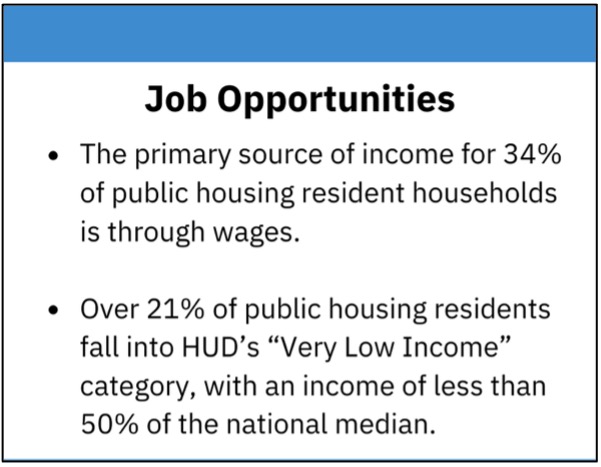
Job Opportunities
According to Healthy People 2030, individuals who have a steady job are less likely to live in poverty. The primary source of income for 34% of public housing resident households is through wages. However, despite the efforts of this working population, more than 21% of public housing residents fall into HUD’s “Very Low Income” category, with an income of less than 50% of the national median. Public housing residents have to decide between housing, healthy food, prescription drugs, etc. so they can make ends meet. As a result, they are prone to develop chronic conditions such as diabetes or cardiovascular diseases when they have to choose from different constraints.
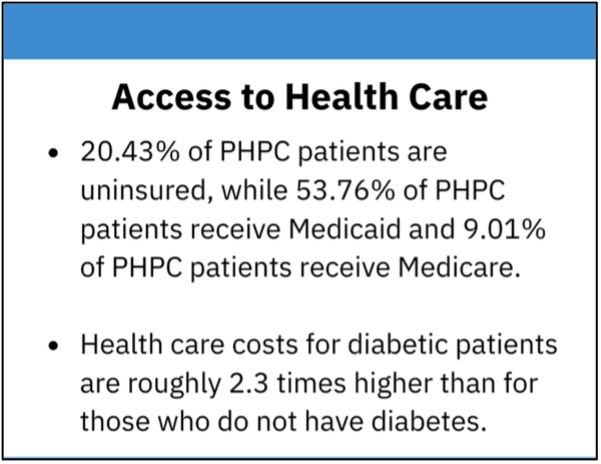
Access to Health Care
A report by the American Diabetes Association shows that health care costs for diabetic patients are roughly 2.3 times higher than for those who do not have diabetes. According to HRSA’s 2019 UDS data1, 20.43% of PHPC health center patients are uninsured, while 53.76% of PHPC health center patients receive Medicaid and 9.01% of PHPC health center patients receive Medicare. Access to health insurance allows patients to have routine and preventative visits, lower out of pocket costs for diabetes medications, equipment, and improve their HbA1C levels through diabetes prevention and self-management programs.
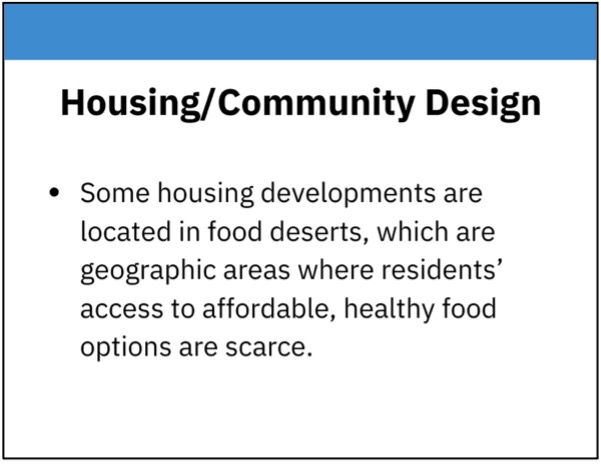
Housing/Community Design (built environment)
A recent study reveals that walkable neighborhoods with access to green space are associated with a lower rate of diabetes. Unfortunately, rates of violent crime are higher in areas where PHPC Health Centers are located compared to the national average. This can serve as an inconvenience for public housing residents because increased crime can make it more difficult for residents to exercise outside of their homes and find places with healthy food options. In fact, some housing developments are located in food deserts, which are geographic areas where residents’ access to affordable, healthy food options are scarce (especially fresh fruits and vegetables). Access to healthy food is restricted or nonexistent due to the absence of grocery stores within convenient traveling distance. As a result, public housing residents’ diet is substantially affected, and this social determinant limitation makes them more likely to have carbohydrate-rich diets with low protein content. A poor diet and lack of exercise increases the Body Mass Index (BMI) of this population in the short term and predisposes them to developing diabetes in the future.
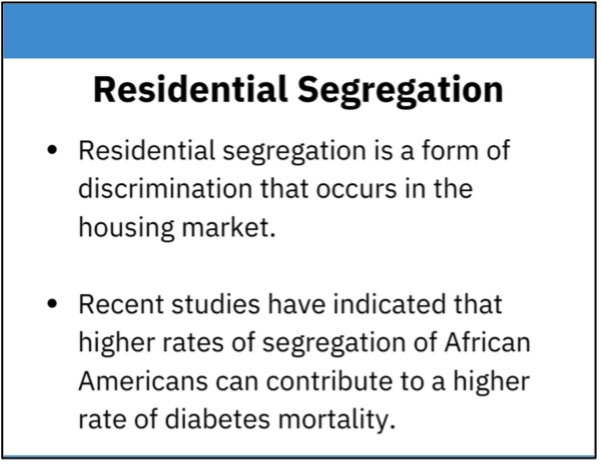
Residential Segregation
Residential segregation is a form of discrimination that occurs in the housing market. Recent studies have indicated that higher rates of segregation of African-Americans can contribute to a higher rate of diabetes mortality. Studies show that American Indian and Alaska Native populations also experience residential segregation. Public housing developments are sometimes located in urban and rural areas where residential segregation occurs.
While individuals experiencing residential segregation do have proper access to primary care physicians, they also experience problems with accessing specialty providers.
This can be problematic for diabetic patients because it is important for them to be able to see specialists such as endocrinologists, eye doctors, and dentists since diabetes complications are linked to higher rates of blindness, periodontal diseases, kidney disease, etc.

English Proficiency
In a 2019 report from HRSA1, roughly 34.82% of PHPC health center patients were better served in a language other than English. Limited English language skills and poor health literacy have a direct correlation to lower education and unfavorable health outcomes. If someone does not possess language proficiency, this could potentially result in an inability for the provider to facilitate proper medication use in addition to medical services designed to prevent and/or manage diabetes.
Over the last three years, NCHPH has had conversations with health centers located in or immediately accessible to public housing. In addition to addressing clinical issues, health centers serving public housing residents have been working diligently to reduce some of the social determinants of health affecting the quality of life of persons living with diabetes. NCHPH has compiled a list of best practices addressing community violence, health literacy and other social issues affecting public housing residents with diabetes.
- Confronting Community Violence: An Outdoor Exercise Program for Patients with Diabetes
El Rio Health Center works with the National Park Service to prescribe park and guided activities to public housing residents. The Health Center has secured funding for transportation and admission fees for their patients. This can help diabetic patients by incorporating exercise into their daily routines in areas where there is community violence.
- Increasing Access to Care: Community Collaborations between Public Housing Agencies and Health Centers
Public Health Management Corporation and Philadelphia Housing Authority have worked together for over 20 years to provide comprehensive care to public housing residents. They are strategic partners that pool resources to advance each other’s mission. Since quality health care is very important for diabetic patients, this partnership is very helpful. These two organizations have developed agreements to provide health services on public housing premises for the elderly and those with physical and developmental disabilities.
Quality of Life Health Services and Greater Gadsden Housing Authority transformed their city from a violent, gang-ridden community to a place where public housing residents felt safe and secure. Their shared vision and commitment to the residents, and collaboration with local police and community organizations, has led to a different culture at the housing development. It has reduced the stigma of public housing, improved community cohesion, and increased access to health and social services for this hard-to-reach population. This is important since there are typically higher crime rates in PHPC health center areas.
- Reducing Health Literacy and Language Barriers: Language Assistance Services
OLE Health in Napa, California has bilingual staff members and they have trained volunteers to provide interpreting services for patients. Telephone interpretation for patients is also a service that is offered by this health center. Having bilingual staff members helps with the English proficiency gap in health center patients.
- Providing Transportation Services: Dental Health Services for At-Risk and Vulnerable Populations in Public Housing
Zufall Health Center and Madison Housing Authority collaborate on programs for seniors, including a mobile dental health van and a senior health education series. Their partnership has created a stable source of oral health care for public housing residents and those living in public housing and Section 8 housing throughout the city. This is important because patients with diabetes are more likely to have periodontal disease. Diabetes is a complex chronic condition prevalent in public housing, and there are numerous social determinants of health playing a role in public housing residents’ ability to manage their diabetes. However, health centers are not only working to improve the clinical component of diabetes, but address social determinants of health and, therefore, establishing a solid quality improvement framework for diabetes prevention and management in this special population.
1 In the link, select the year 2019 followed by Public Housing Primary Care, then demographic characteristics.
Resources/Tools:
- Unstable Housing and Diabetes-Related Emergency Department Visits and Hospitalization: A Nationally Representative Study of Safety-Net Clinic Patients
https://bit.ly/2M4YTkI - Social Determinants of Health: Diabetes
https://bit.ly/3qU8OIw - Social Determinants of Health: Access to Healthy Food
https://bit.ly/3cdxJCT - Literacy Assessment for Diabetes
https://bit.ly/2Yh60ck - Assessing the Literacy Skills of Your Adult Patients
https://bit.ly/3iNt7EM - Public Housing Primary Care Health Centers and Diabetes Map
https://bit.ly/36c8RaE - Social Determinants of Health: Community Violence
https://bit.ly/3dpuUPR - HRSA National Health Center Data
https://data.hrsa.gov/tools/data-reporting/special-populations - Healthy People 2030: Language and Literacy
https://health.gov/healthypeople/objectives-and-data/social-determinants-health/literature-summaries/language-and-literacy - Healthy People 2030: Discrimination
https://health.gov/healthypeople/objectives-and-data/social-determinants-health/literature-summaries/discrimination - Social Determinants of Health and Diabetes: A Scientific Review
https://care.diabetesjournals.org/content/early/2020/10/31/dci20-0053 - Diabetes and Oral Health
https://www.nidcr.nih.gov/health-info/diabetes - Racial/Ethnic Residential Segregation, Obesity, and Diabetes Mellitus
https://pubmed.ncbi.nlm.nih.gov/27664041/ - Do Diabetic Patients Living in Racially Segregated Neighborhoods Experience Different Access and Quality of Care?
https://europepmc.org/article/pmc/pmc3394874 - Public Housing Demographics Fact Sheet
https://nchph.org/wp-content/uploads/2019/08/Demographics-Fact-Sheet-2019.pdf
Disclaimer:
This publication is supported by the Health Resources and Services Administration (HRSA) of the U.S. Department of Health and Human Services (HHS) as part of an award totaling $2,006,400 with 0% financed with non-governmental sources. The contents are those of the author(s) and do not necessarily represent the official views of, nor an endorsement, by HRSA, HHS, or the U.S. Government. For more information, please visit HRSA.gov.
